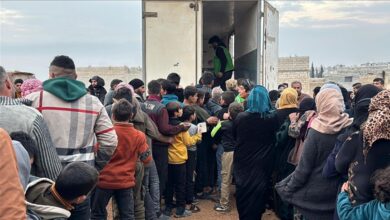
82 thousand barrel bombs dropped by the Assad regime’s warplanes during nine years, killing 11,087 civilians
The Syrian Network for Human Rights said, in its report released today, that the Assad regime dropped nearly 82,000 barrel bombs over the course of nine years, killing 11,087 civilians, including 1,821 children, indicating that the Security Council Resolution 2139 must be implemented and the perpetrators of indiscriminate bombings held accountable
destruction and forced displacement.
The 35-page report described the barrel bombing as primitive and barbaric, and considered its use as a disgrace even among the world’s weakest armies, and said that the Assad regime had used various types of weapons during the past nine years; To suppress the popular uprising that turned into an internal armed conflict in 2012, the Assad regime gradually used weapons, and what characterized the brutality of the Assad regime, according to the report, was its use of chemical weapons and barrel bombs.
The report attributed the Assad regime’s extensive use of this weapon for several reasons, the first of which is the lack of a deterrent response by the Security Council and the international community to the use of such a primitive and barbaric weapon, and the second is that it is a homemade weapon, simple in the manufacturing process, low in cost, with a high destructive capacity about seven mortars are equivalent to a barrel, in addition to the Assad regime’s indifference to the indiscriminate range of this weapon and not distinguishing it between a civilian or a combatant, as the barrel is often thrown from helicopters depending on the principle of free fall, so it amounts to a war crime. Al-Assad does not care about the reputation of the military establishment, but rather uses it as a tool in maintaining power.
Fadel Abdul-Ghani, director of the Syrian Network for Human Rights, says: “We no longer hear even condemnations of the Assad regime’s use of barrel bombs against civilians, as its strategy is to repeat bombing hundreds or thousands of times until condemnation or documentation becomes futile, and the Syrian society reaches a stage of despair and surrender, and the Security Council is responsible for implementing its decision. It has failed to do so since the decision was issued in February 2014, and the failure is still sustainable so far.
The report mentioned the outcome of the Assad regime’s use of barrel bombs since the first documented use of this weapon in July 2012 until April 2021, and the victims and attacks on vital civilian centers that resulted from this use. It also reviewed prominent incidents that occurred after the issuance of the previous expanded report issued by the Syrian Network For human rights in 2017.
The report documented the killing of 11,087 civilians, including 1,821 children, and 1,780 women (adult female) as a result of the Assad regime’s use of barrel bombs from July 2012 until April 2021, and the death toll of children and women constitutes approximately 33% of the civilian death toll, which is a very high rate and stresses that the attacks targeted civilians.
The report included graphs that showed the cumulative index of barrel bombs and their distribution according to years and according to the Syrian governorates, and the distribution of barrel bombs in each governorate over years. The data analysis showed that the governorates of Damascus and its countryside recorded the highest number of barrel bombs (about 29% of the total toll), followed by Aleppo. (About 21%), then Daraa (about 14%) and Idlib (about 13%). The year 2014 witnessed the highest toll of barrel bombs, followed by 2015 and 2013, when the three years witnessed the Syrian Air Force throwing at least 51,948 barrel bombs, or 64% of the total number recorded in the report.
The report included graphs that showed the cumulative indicator of the death toll, its distribution according to years, and according to the Syrian governorates, and the distribution of the death toll in each governorate over the years, and the analysis of the data showed that the largest number of victims was in the governorate of Aleppo (about 52%) and then Idlib (about 17%). Daraa (approximately 11%). While the highest death toll was in 2014 and 2015, the civilian death toll in these two years was approximately 69% of the total death toll.
The report added, “The barrel bomb attacks caused no less than 728 attacks on vital civilian centers, including 104 on medical facilities, 188 on schools, 205 on mosques, and 57 on markets. The report mentioned the distribution of this outcome over the years, which showed that the highest number of accidents The attack on civilian vital centers was in 2015, followed in 2014 and 2016.
According to recent estimates by the United Nations High Commissioner for Refugees, there are approximately 13.3 million Syrians between displaced and refugees, and the report estimates that nearly 70% of them, or 9.5 million forcibly displaced persons, left their homes as a result of the air strikes launched mainly by the Syrian-Russian alliance forces barrel bombs have a great impact due to their randomness and great destructive effect.
Source: Sham News




